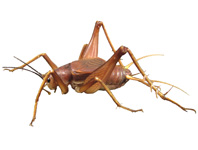Abstract
The Ribbed newts (genus Pleurodeles) are endemic to the Iberian Peninsula and northwest Africa (Raffaëlli 2013), and comprise three species: Pleurodeles nebulosus (Guichenot 1850), Pleurodeles poireti (Gervais 1836) and Pleurodeles waltl Michahelles 1830. Pleurodeles nebulosus is found in northern Algeria and Tunisia with an average size of 18 cm, while P. poireti is endemic to the Edough Massif, in northeastern Algeria and is the smallest species, with 12.9 cm in total length (Escoriza et al. 2016; Carranza & Wade 2004). Pleurodeles waltl appears on the Iberian Peninsula and Morocco (García-París et al. 2004). The eastern and western populations of P. waltl although they are not differentiated taxonomically show high levels of genetic divergence (estimated to have occurred 2.0–3.2 Ma; Carranza & Arnold 2003). The individuals of P. waltl attain large sizes (30 cm of total length) and have 8−10 cutaneous glands on both sides (Pasteur 1958), which are absent in other species of the genus.
References
Anderson, M.J. (2001) A new method for non-parametric multivariate analysis of variance. Austral Ecology, 26, 32–46.
Ben Hassine, J. & Escoriza, D. (2014) New ecological data on the family Salamandridae in the Maghreb. Herpetological Review, 45, 1−5.
Bookstein, F.L., Chernoff, B., Elder, R.L., Humphries, J.M. Jr., Smith, G.R. & Strauss, R.E. (1985) Morphometrics in Evolutionary Biology. Special publication 15. Academy of Natural Sciences Press, Philadelphia, 277 pp.
Carranza, S. & Arnold, E.N. (2003) History of West Mediterranean newts, Pleurodeles (Amphibia: Salamandridae), inferred from old and recent DNA sequences. Systematics and Biodiversity, 1, 327–337.
https://doi.org/10.1017/S1477200003001221Carranza, S. & Wade, E.D. (2004) Taxonomic revision of Algero-Tunisian Pleurodeles (Caudata: Salamandridae) using molecular and morphological data. Revalidation of the taxon Pleurodeles nebulosus (Guichenot, 1850). Zootaxa, 488 (1), 1−24.
https://doi.org/10.11646/zootaxa.488.1.1Escoriza, D., Gutiérrez-Rodriguez, J., Ben Hassine, J. & Martínez-Solano, I. (2016) Genetic assessment of the threatened micro-endemic Pleurodeles poireti (Caudata, Salamandridae), with molecular evidence for hybridization with Pleurodeles nebulosus. Conservation Genetics, 17, 1445–1458.
https://doi.org/10.1007/s10592-016-0875-9Gallien, L. & Durocher, M. (1957) Table chronologique du développement chez Pleurodeles waltlii Michah (avec planches I-III). Bulletin Biologique de la France et de la Belgique, 2, 97–114.
Garcia, T.S. & Sih, A. (2003) Color change and color-dependent behavior in response to predation risk in the salamander sister species Ambystoma barbouri and Ambystoma texanum. Oecologia, 137, 131−139.
https://doi.org/10.1007/s00442-003-1314-4García-Paris, M., Montori, A. & Herrero, P. (2004) Amphibia-Lissamphibia. Museo Nacional de Ciencias Naturales-CSIC, Madrid, 640 pp.
Heckert, P. (1982) Colour image quantization frame buffer display. ACM Transactions on Graphics, 16, 297–304.
https://doi.org/10.1145/965145.801294Iwata, H. & Ukai, Y. (2002a) SHAPE: a computer program package for quantitative evaluation of biological shapes based on elliptic Fourier descriptors. Journal of Heredity, 93, 384−385.
https://doi.org/10.1093/jhered/93.5.384Iwata , H. & Ukai, Y. (2002b) SHAPE. Version 1.3. Available from: http://lbm.ab.a.u-tokyo.ac.jp/~iwata/shape/ (accessed 12 January 2014)
Lanza, B., Andreone, F., Bologna, M.A., Corti, C. & Razzetti, E. (2007) Fauna d’Italia. Amphibia. Calderini, Bologna, 538 pp.
Nadimpalli, U.D., Price, R.R., Hall, S.G. & Bomma, P. (2006) A comparison of image processing techniques for bird recognition. Biotechnology Progress, 22, 9−13.
https://doi.org/10.1021/bp0500922Pasteur, G. (1958) Sur la systématique des espèces du genre Pleurodeles (Salamandridés). Bulletin de la Sociéte des Sciences Naturelles et Physiques du Maroc, 38, 157–165.
Petranka, J.W. (1998) Salamanders of the United States and Canada. Smithsonian Institution Press, Washington, 592 pp.
R Development Core Team (2016) R package vs 3.3.1. R Foundation for Statistical Computing, Vienna. Available from: https://cran.r-project.org/bin/windows/base/ (accessed 10 April 2016)
Raffaëlli, J. (2013) Les Urodèles du Monde. Conde-sur-Noireau, Penclen, 480 pp.
Rasband, W.S. (2015) ImageJ vs 1.50e. Available from: http://rsb.info.nih.gov/ij/ (accessed 8 March 2015)
Shi, D.L. & Boucaut, J.C. (1995) The chronological development of the urodele amphibian Pleurodeles waltl (Michah). International Journal of Developmental Biology, 39, 427−441.
Van Buskirk, J. & Schmidt, B.R. (2000) Predator-induced phenotypic plasticity in larval newts: trade-offs, selection, and variation in nature. Ecology, 81, 3009–3028.
https://doi.org/10.2307/177397Walls, S.C., Beatty, J.J., Tissot, B.N., Hokit, D.G. & Blaustein, A.R. (1993) Morphological variation and cannibalism in a larval salamander (Ambystoma macrodactylum columbianum). Canadian Journal of Zoology, 71, 1543−1551.
https://doi.org/10.1139/z93-218

